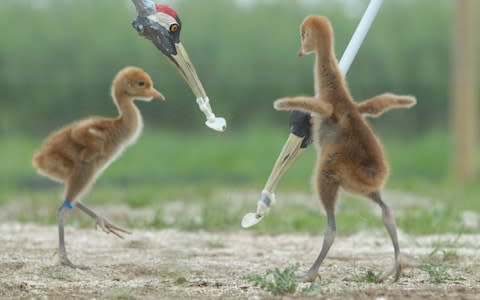Common crane enjoys best year in UK since 17th Century, RSPB says

The common crane has enjoyed its best year in UK since 17th Century after successful breeding programme saw carers dressed as cranes nurse the birds back into the wild.
RSPB’s latest survey of the UK’s biggest bird revealed a record of 54 pairs of cranes across the UK this year, with the total population coming in around 180 birds.
This year’s figures come in at the highest since cranes returned to the country in 1979 after missing for four centuries.
It comes after an intensive breeding programme which saw “crane parents” from the Great Crane Project - a conservation project between the Wildfowl and Wetland Trust at Slimbridge, the RSPB and Pensthorpe Conservation Trust - dressed head to toe in grey running around a bird enclosure in Gloucestershire.

The volunteers from the project waved wooden poles and chicks were fed with customised litter pickers, decorated to look like the bird’s beaks.
Following their efforts, cranes built their first nest in Gloucestershire in 2013 which began the West Country’s first sustainable crane population since the Civil War - it has continued to grow since.
Damon Bridge, Chair of the UK Crane Working Group said: “To see them starting to spread back across the country after all this time is just brilliant - and a true reflection of how important the UK’s wetland habitats are to cranes as well as the many other species they support.”
Common cranes were wiped out from Britain 400 years ago after being hunted to extinction when Elizabethans pursued them serve and eat at court feats.
Combined with a loss of their natural wetland habitat, the birds were gone from Britain by 1600.
A small number of wild cranes returned to the UK and were found in the Norfolk Broads in 1979, it is expected that they migrated from Northern Europe.
Due to their sparsity, their location was originally kept a secret to fend off egg collectors whilst wildlife experts began a structured programme to improve the existing habitat and hand-rear birds for release on the Somerset Levels and Moors to help boost the UK's population.

In 2009, the Great Crane Project also brought extra eggs over from Germany to be incubated, hatched and hand-reared before being released into the wild in Somerset.
Andrew Stanbury, RSPB Conservation scientist said: “This success story highlights the importance of the UK’s protected sites and nature reserves. RSPB sites alone hold 30% of the UK breeding population. These special places offer the seclusion necessary for cranes to breed successfully. For this expansion to continue we need to better protect existing sites and look to creating and maintaining others.”

 Yahoo News
Yahoo News 